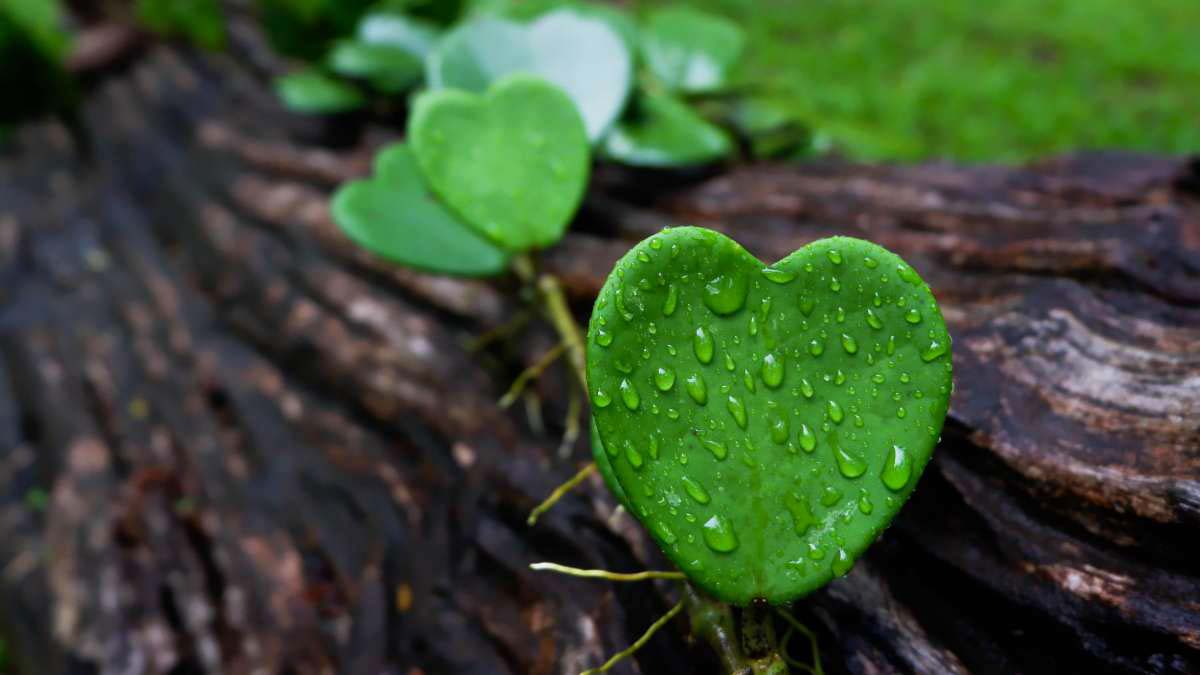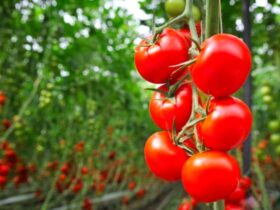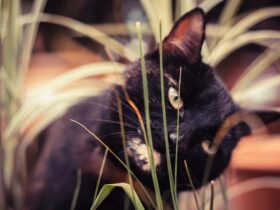Hoya plants come in various types, including carnosa, compacta, pubicalyx, and kerrii. Hoya plants offer a stunning variety of shapes, sizes, and colors, making them highly sought after by both indoor and outdoor garden enthusiasts.
These versatile plants are known for their attractive wax-like flowers and thick, succulent leaves. Hoya carnosa, with its star-shaped pink or white flowers, is one of the most popular varieties. Hoya compacta is characterized by its twisted, vine-like stems and clusters of fragrant, star-shaped flowers.
Hoya pubicalyx has elongated leaves and produces clusters of dark purple flowers. Hoya kerrii, also known as the sweetheart plant, is adored for its heart-shaped leaves. Whether you’re a seasoned plant collector or a beginner, Types of Hoya Plants are a fantastic addition to any home or garden.
1. Hoya Carnosa – Types of Hoya Plants
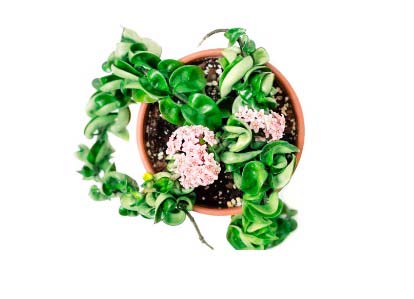
Hoya Carnosa, also known as the Wax Plant or Hindu Rope Plant, is a popular and stunning variety of Hoya plants. Its unique and distinctive features make it a favorite among indoor plant enthusiasts. Let’s take a closer look at Hoya Carnosa.
Description
Hoya Carnosa is a trailing vine that can grow up to 4 to 6 feet in length. It is native to Eastern Asia and Australia and is characterized by its thick, waxy leaves that have a glossy appearance. The leaves are usually dark green with lighter-colored veins, adding to its visual appeal.
One of the most fascinating aspects of Hoya Carnosa is its clusters of small, star-shaped flowers. These flowers are typically white or pink in color and have a sweet, pleasant fragrance. The flowers bloom in rounded clusters called umbels, making them a delightful sight to behold.
Care Tips
Providing the right care for your Hoya Carnosa is essential to ensure its health and growth. Here are some care tips to keep in mind:
- Light: Hoya Carnosa thrives in bright, indirect light. Place it near a window that receives partial sunlight or provide artificial light if necessary.
- Watering: It is important to allow the soil to dry partially between waterings. Water sparingly, taking care not to overwater, as excessive moisture can lead to root rot.
- Temperature and Humidity: Hoya Carnosa prefers moderate to warm temperatures, ideally between 60°F to 75°F (15°C to 24°C). It also enjoys humidity levels of around 40 to 60%, so consider using a humidifier or placing a water tray near the plant.
- Soil and Fertilizer: Well-draining soil is essential for Hoya Carnosa. A mix of peat moss, perlite, and orchid bark can provide the ideal growing medium. Fertilize sparingly during the growing season with a balanced, water-soluble fertilizer.
- Pruning: To encourage bushier growth and control the plant’s size, you can trim back the vines. Prune after the plant has finished blooming.
By following these care tips, you can enjoy the beauty of Hoya Carnosa and create a thriving environment for this magnificent plant.
2. Hoya Pubicalyx -Types of Hoya
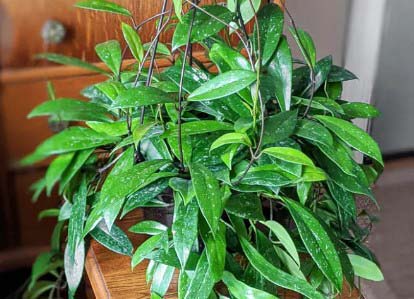
The Hoya Pubicalyx is a stunning variety of Hoya plants that are known for their beautiful foliage and delicate flowers. This popular houseplant is native to the Philippines and has become a favorite among plant enthusiasts due to its low maintenance requirements and striking appearance.
Description
The Hoya Pubicalyx features long, vining stems that can reach several feet in length. The leaves are glossy and dark green, with hints of maroon on the undersides. The new growth often emerges with a reddish hue, adding to its visual appeal. One of its standout features is the clusters of star-shaped flowers that bloom in shades of pink, red, or purple. These blossoms have a sweet, aromatic fragrance that fills the air, making it a popular choice for those who want to add a touch of natural beauty and fragrance to their indoor spaces.
Care Tips
Proper care is essential to keep your Hoya Pubicalyx thriving and healthy. Here are some care tips to help you maintain this stunning plant:
- Light: Place your Hoya Pubicalyx in bright, indirect light. While it can tolerate some shade, it prefers bright, filtered light for optimal growth and flowering.
- Temperature: The Hoya Pubicalyx thrives in average room temperatures between 60°F and 80°F (15°C to 27°C). Avoid exposing it to extreme temperature fluctuations.
- Water: Allow the top few inches of soil to dry out between waterings. Overwatering can lead to root rot, so it’s important to practice moderation when watering your Hoya Pubicalyx.
- Humidity: While the Hoya Pubicalyx can tolerate average indoor humidity levels, it thrives in higher humidity. Placing a humidifier nearby or misting the leaves occasionally can help create a suitable environment for this plant.
- Soil: Use a well-draining potting mix to prevent waterlogging and root rot. A mix of peat moss, perlite, and orchid bark works well for Hoya Pubicalyx.
- Fertilizer: Feed your Hoya Pubicalyx with a balanced houseplant fertilizer during the growing season (spring and summer). Dilute the fertilizer to half-strength to avoid overfertilizing.
With the right care and attention, your Hoya Pubicalyx will reward you with its stunning foliage and charming flowers. Remember to monitor its growth, provide appropriate light and water, and create a suitable environment, and you’ll enjoy this beautiful plant for years to come.
3. Hoya Kerrii – Types of Hoya Plants
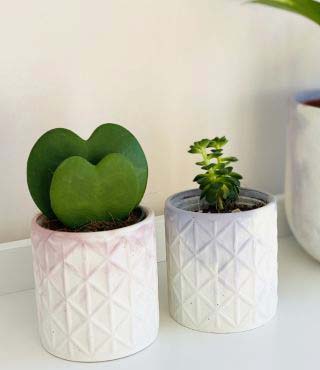
Hoya Kerrii, also known as the sweetheart plant, is a popular type of hoya plant. With its heart-shaped leaves, it adds charm and beauty to any garden or indoor space. Whether you’re a beginner or seasoned gardener, this hoya plant is a great addition to your collection.
The Hoya Kerrii, also known as the Sweetheart Plant or Valentine Plant, is a beloved member of the Hoya family. With its heart-shaped leaves and low-maintenance nature, this plant has captured the hearts of many plant enthusiasts.
Description
The Hoya Kerrii is a tropical succulent native to Southeast Asia. Its unique heart-shaped leaves make it a popular choice for gifting during special occasions like Valentine’s Day or anniversaries. The leaves vary in size, with some growing as large as a human hand, while others remain small and compact.
This charming plant is often potted as a single leaf with its stem, creating a striking display of nature’s love. However, it can also be found with multiple leaves on a single stem, forming a fuller plant. The leaves are thick and waxy, giving them a glossy appearance.
While the leaves are the star attraction, the Hoya Kerrii may occasionally produce clusters of fragrant, star-shaped flowers. The blooms range in color from pale pink to white and can be a delightful surprise.
Care Tips
Although the Hoya Kerrii is an easy-to-care-for plant, there are a few essential care tips to ensure its well-being:
- Light: Place your Hoya Kerrii in bright, indirect light. Avoid direct sunlight, as it can scorch the leaves.
- Temperature: Keep the plant in a warm environment with temperatures between 60°F and 75°F (15°C – 24°C). Protect it from extreme temperature fluctuations.
- Water: Water your Hoya Kerrii when the top inch of soil feels dry. Overwatering can lead to root rot, so ensure proper drainage.
- Humidity: Provide moderate humidity for your plant by misting the leaves or placing it on a tray of water-filled pebbles.
- Soil: Use a well-draining potting mix specifically designed for succulents or cacti to ensure proper moisture retention.
- Fertilizer: Feed your Hoya Kerrii with a balanced, water-soluble fertilizer once a month during the growing season (spring and summer).
- Pruning: To encourage bushier growth, pinch off the tips of the vines. You can also propagate new plants by rooting stem cuttings in water or soil.
By following these care tips, you can enjoy the beauty and longevity of your Hoya Kerrii. Whether you’re a seasoned plant enthusiast or just starting your green journey, this charming plant will bring love and joy to your space.
4. Hoya Compacta – Different Types
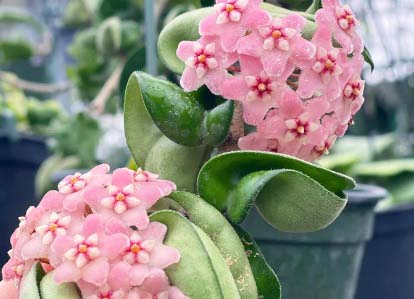
Hoya Compacta, also known as the Hindu Rope plant, is a popular type of Hoya plant. It features twisted, compact leaves that give it a unique look, making it a favorite among plant enthusiasts.
Hoya Compacta, commonly known as the Hindu Rope Plant or Krinkle Kurl, is a unique and fascinating type of Hoya that is highly sought after by plant enthusiasts. Its distinctive appearance, with long, trailing vines and curled, waxy leaves, makes it a visually striking addition to any indoor space.
Description
The Hindu Rope Plant is native to East Asia and belongs to the Apocynaceae family. One of its most remarkable features is its thick, twisted and contorted leaves, giving it the appearance of a rope or a corkscrew. The leaves are typically dark green in color, but some varieties may exhibit variegation with shades of cream or pink.
Hoya Compacta blooms clusters of small, star-shaped flowers with a distinct fragrance. These blooms are typically pink or reddish in color and can add a delightful touch to the overall aesthetic of the plant. The scent of the flowers is often described as sweet and enticing, attracting pollinators like bees and butterflies.
This Hoya species is a slow-growing plant, but with proper care, it can thrive and reach impressive lengths. The vines can grow up to several meters long, making it an excellent choice for hanging baskets or trailing down from shelves and countertops.
Care Tips
Providing the right care for your Hoya Compacta is essential to keep it healthy and thriving. Here are some care tips to help you maintain this remarkable plant:
- Light: Hoya Compacta prefers bright, indirect light. Place it near a north or east-facing window where it can receive bright, filtered sunlight. Avoid exposing it to direct sunlight, as it can scorch the leaves.
- Temperature: This plant enjoys warm temperatures, ideally between 65°F and 80°F (18°C-27°C). Avoid exposing it to cold drafts or sudden temperature changes, as it can be detrimental to its growth.
- Watering: Allow the soil to dry partially between waterings. It’s essential to strike a balance between keeping the soil moist and avoiding overwatering, as Hoya Compacta is susceptible to root rot. Check the top inch of soil regularly, and water when it feels slightly dry to the touch.
- Humidity: Hoya Compacta thrives in high humidity environments. To increase humidity levels, you can mist the leaves regularly or place the plant on a tray filled with pebbles and water. Avoid placing it near dry heating vents.
- Soil and Fertilizer: Plant your Hoya Compacta in well-draining soil, preferably a mixture of peat moss, perlite, and orchid bark. Fertilize the plant once a month during the growing season using a balanced houseplant fertilizer diluted to half strength.
- Pruning: Regular pruning can help maintain the shape and size of your Hindu Rope Plant. Prune any leggy or overgrown vines to encourage bushier growth. You can also propagate cuttings from pruning to expand your plant collection or share with fellow plant enthusiasts.
By following these care tips, you can provide a suitable environment for your Hoya Compacta and enjoy its unique beauty for years to come.
5. Hoya Australis – Unique Types
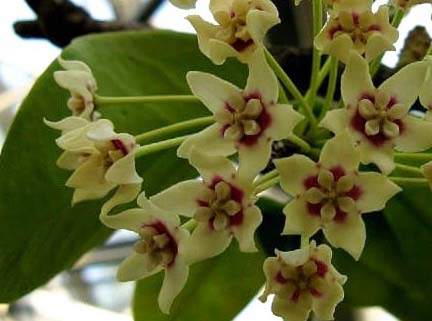
Hoya Australis is one of the popular types of Hoya plants, known for its lovely green leaves and unique spiky flowers. It is a charming addition to any indoor or outdoor garden, thriving in bright light and well-draining soil.
One of the most popular species of Hoya plants is the Hoya Australis. With its stunning foliage and delicate flowers, this plant is a must-have for any plant enthusiast. Let’s delve into its description and learn some valuable care tips to ensure its healthy growth.
Description
The Hoya Australis, also known as the “Wax Plant,” is native to Eastern Australia. It is a vine that produces long, trailing stems covered in glossy, succulent-like leaves. The leaves are typically heart-shaped, making the plant visually appealing.
The Hoya Australis also features clusters of fragrant, star-shaped flowers that bloom in shades of pink, white, or cream. These beautiful blossoms add a touch of elegance to any indoor or outdoor setting.
Care Tips
To ensure the optimal health and growth of your Hoya Australis, follow these care tips:
Light: Place your Hoya Australis in bright, indirect light. It thrives in partial shade but can tolerate some direct sunlight.
Temperature: This plant prefers warmer temperatures ranging from 60°F to 80°F (15°C to 27°C). Protect it from drafts and sudden temperature fluctuations.
Watering: Water your Hoya Australis thoroughly, allowing the soil to dry out partially between waterings. Overwatering can lead to root rot, so ensure proper drainage.
Soil: Use well-draining soil that retains some moisture but doesn’t become soggy. A mix of potting soil, perlite, and orchid bark works well.
Fertilizer: Feed your Hoya Australis with a balanced, liquid fertilizer during the growing season (spring and summer) every 2-4 weeks. Dilute the fertilizer to half strength to avoid overfeeding.
Propagation: You can propagate your Hoya Australis through stem cuttings. Simply cut a healthy stem below a node and place it in water or moist soil until it develops roots. Once rooted, transplant it into a well-draining potting mix.
Pruning: To maintain a compact and bushy appearance, prune your Hoya Australis by pinching off the growing tips. You can also trim any leggy or damaged growth.
Pests and Diseases: Keep an eye out for common pests like mealybugs and spider mites. Treat any infestations promptly with an appropriate insecticidal soap or horticultural oil.
Support: As a vine, the Hoya Australis benefits from a support structure, such as a trellis or moss pole, to help it climb and cascade naturally.
By following these care tips, your Hoya Australis will thrive and reward you with its stunning foliage and charming flowers.
6. Hoya Lacunosa – Types of Hoya Plants
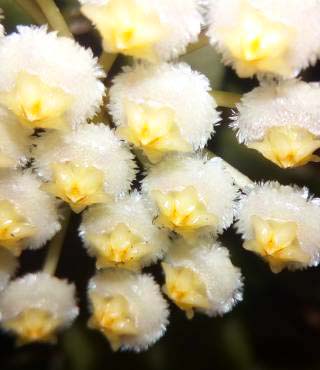
Hoya Lacunosa, popularly known as the “Wax Plant,” is a stunning addition to any indoor garden. With its delicate and exotic appearance, this Hoya plant is sure to become the centerpiece of your collection.
Description
Hoya Lacunosa is native to Southeast Asia and is characterized by its cascading vines and glossy, succulent leaves. The leaves are typically heart-shaped and have a unique texture, giving them a waxy and translucent appearance. What makes this variety truly captivating is its clusters of small, star-shaped flowers that bloom in shades of white or pale pink. The fragrant blossoms make it an excellent choice for adding a touch of beauty and fragrance to your living space.
Care Tips
Caring for Hoya Lacunosa is relatively easy, making it an ideal plant for beginners and experienced gardeners alike. Here are some essential care tips to help your Hoya Lacunosa thrive:
- Light: Place your Hoya Lacunosa in bright, indirect sunlight. Avoid exposing it to direct sunlight for extended periods as this can scorch the leaves.
- Temperature: This Hoya plant prefers warm temperatures ranging between 65°F and 80°F (18°C – 27°C). Protect it from drafty areas and extreme temperature fluctuations.
- Watering: Allow the top inch of soil to dry out before watering your Hoya Lacunosa. Overwatering can lead to root rot, so it’s essential to maintain a well-draining potting mix and avoid waterlogged conditions.
- Humidity: Hoya Lacunosa thrives in high humidity. Consider placing a tray of water near the plant or using a humidifier to increase humidity levels.
- Fertilization: Feed your Hoya Lacunosa with a balanced liquid fertilizer once a month during the growing season (spring and summer). Reduce fertilization during the winter months.
- Propagation: Hoya Lacunosa can be easily propagated through stem cuttings. Simply take a cutting with at least two nodes, let it dry for a few days, and then plant it in a well-draining potting mix. Keep the soil lightly moist until new roots develop.
With these simple care guidelines, you can enjoy the beauty of the Hoya Lacunosa and marvel at its underrated charm. Whether you’re a seasoned plant enthusiast or just beginning your plant collection, the Hoya Lacunosa is sure to captivate your heart with its exquisite foliage and delicate, fragrant flowers.
7. Hoya Shepherdii – Types of Hoya Plants
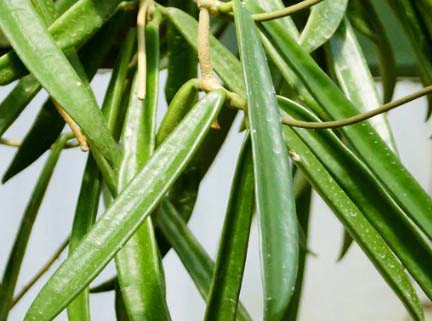
Hoya Shepherdii is one of the various types of Hoya plants. Its stunning heart-shaped leaves and white flowers make it a popular choice among plant enthusiasts. Known for its easy-care nature, Hoya Shepherdii adds a touch of elegance to any indoor or outdoor space.
One of the most popular types of Hoya plants is Hoya Shepherdii. This beautiful plant, known for its heart-shaped leaves and cascading vines, is a favorite among plant enthusiasts. Hoya Shepherdii, also commonly referred to as the “String Bean Hoya,” offers not only aesthetic appeal but also requires minimal care, making it an ideal addition to any indoor garden.
Description
Hoya Shepherdii is characterized by its delicate, waxy leaves that have a glossy texture. The leaves are typically a vibrant green color, resembling the shape of a heart. As the plant matures, it produces numerous vines that can grow up to several feet long. These vines produce clusters of small, star-shaped flowers that give off a sweet fragrance, making the Hoya Shepherdii even more alluring.
One unique feature of Hoya Shepherdii is its ability to produce long, narrow leaves that resemble bean pods. These elongated leaves give the plant its nickname, the “String Bean Hoya.” With its graceful appearance and charming characteristics, Hoya Shepherdii is an excellent choice for both beginner and experienced gardeners.
Care Tips
Hoya Shepherdii is a relatively low-maintenance plant that thrives in bright, indirect light. Placing the plant near a window or in a well-lit area of your home will ensure optimal growth. It is important to note that direct sunlight should be avoided as it may cause the leaves to scorch.
When it comes to watering Hoya Shepherdii, it is best to allow the soil to dry out between waterings. Overwatering can lead to root rot, so it is important to strike a balance. Additionally, using well-draining soil will help prevent excessive moisture retention.
Moreover, Hoya Shepherdii enjoys slightly higher humidity levels, which can be achieved by misting the leaves or placing a tray of water near the plant. Regular fertilization with a balanced houseplant fertilizer during the spring and summer months will promote healthy growth.
- Place Hoya Shepherdii in bright, indirect light.
- Avoid direct sunlight to prevent leaf scorching.
- Water the plant when the soil has dried out.
- Use well-draining soil to prevent root rot.
- Provide slightly higher humidity levels through misting or using a water tray.
- Fertilize regularly during the spring and summer months with a balanced houseplant fertilizer.
By following these care tips, you can ensure that your Hoya Shepherdii thrives and continues to be a stunning addition to your indoor garden. Whether you are a seasoned plant enthusiast or just starting your collection, the Hoya Shepherdii is a delightful plant that will bring beauty and joy to any space.
8. Hoya Carnosa Compacta
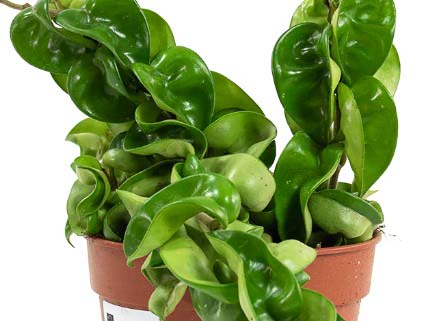
Welcome back to our series on the different types of Hoya plants! In this installment, we’ll be highlighting the Hoya Carnosa Compacta, a popular choice among plant enthusiasts. This unique Hoya variety is known for its compact and twisted foliage, making it an eye-catching addition to any indoor garden or hanging basket. Let’s dive into the details and learn more about this fascinating Hoya variety.
Description
The Hoya Carnosa Compacta, also known as the Hindu Rope Hoya or Krinkle Kurl, is a cultivar of the Hoya Carnosa species. What sets this variety apart from others is its characteristic waxy, twisted, and curled leaves, resembling a cluster of green ropes or curls. Its foliage has a tight-knit pattern that gives it a visually striking appearance, making it a favorite among plant collectors.
This charming plant is native to the tropical regions of Eastern Asia, including India, China, and Thailand, where it thrives in humid climates. It belongs to the family Apocynaceae and is a member of the genus Hoya. Its unique appearance and easy care requirements have made it a popular choice among both beginner and expert plant enthusiasts.
Care Tips
To keep your Hoya Carnosa Compacta thriving, here are some care tips to keep in mind:
- Light: Place your Hoya Carnosa Compacta in bright, indirect light. It can tolerate some morning or evening sun but avoid direct sunlight as it can scorch the leaves.
- Temperature: This Hoya variety prefers average room temperatures between 65°F and 80°F (18°C – 27°C). Protect it from extreme temperature fluctuations.
- Watering: Water your Hoya Carnosa Compacta when the top inch of soil feels dry. Avoid overwatering, as it is more tolerant of underwatering than overwatering.
- Humidity: Provide moderate to high humidity levels for this plant. Mist the leaves occasionally or place a humidity tray nearby to create a humid environment.
- Soil: Use a well-draining potting mix with good aeration, such as a blend of peat moss, perlite, and orchid bark.
- Fertilizer: Feed your Hoya Carnosa Compacta with a balanced liquid fertilizer diluted to half strength once a month during the growing season (spring to summer).
- Pruning: Prune the plant to control its size and promote bushier growth. You can also propagate the pruned sections to share with fellow plant enthusiasts.
With these care tips in mind, you’ll be able to enjoy the beauty of your Hoya Carnosa Compacta for years to come. Remember to observe your plant closely and adjust its care routine based on its specific needs. By providing the right conditions, your Hoya Carnosa Compacta will reward you with its twisting charm and vibrant green foliage.
9. Hoya Wayetii
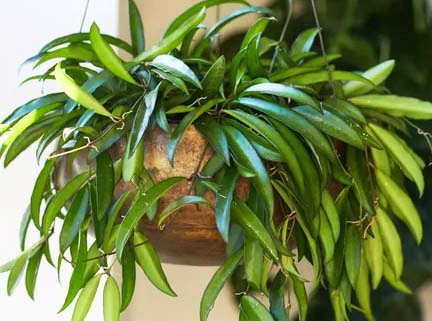
Hoya Wayetii is a popular type of Hoya plant, known for its stunning leaves that are adorned with unique patterns. With its easy care requirements, it makes a great addition to any indoor garden or plant collection.
Description
The Hoya Wayetii is an exotic and charming plant that belongs to the Hoya family, known for its succulent, waxy leaves and beautiful clusters of fragrant flowers. Native to Southeast Asia, this plant has become a favorite among indoor gardeners due to its unique appearance and low maintenance requirements. The Wayetii variety is distinguished by its heart-shaped leaves with prominent silver markings, which add a touch of elegance to any space.
When it comes to size, the Hoya Wayetii can reach lengths of up to six feet, making it a perfect choice for hanging baskets or trailing across shelves. Whether you’re a seasoned plant enthusiast or a beginner, the Wayetii is sure to captivate you with its delicate beauty and easy-going nature.
Care Tips
When it comes to caring for your Hoya Wayetii, here are a few key tips to keep in mind:
- Light: Place your Wayetii near a sunny window to provide it with bright, indirect light. Avoid exposing it to direct sunlight, as this can scorch the leaves.
- Temperature: This tropical plant thrives in warm temperatures, ideally between 65°F and 80°F. Protect it from drafts and cold temperatures, as they can stunt its growth.
- Watering: The Wayetii prefers slightly dry conditions, so be careful not to overwater. Allow the top inch of soil to dry out between waterings. During the winter months, reduce watering further to prevent root rot.
- Humidity: Being a tropical plant, the Hoya Wayetii appreciates higher humidity levels. You can mist the leaves occasionally or place a tray of water near the plant to increase humidity.
- Fertilizer: Feed your Wayetii with a balanced, water-soluble fertilizer once a month during the growing season (spring and summer). However, be cautious not to over-fertilize, as this can damage the plant.
- Pruning: To maintain a compact and bushy shape, prune any leggy or excess growth. You can propagate the cuttings in water or well-draining soil to propagate new plants.
With proper care and attention, the Hoya Wayetii will thrive and reward you with its stunning foliage and occasional clusters of fragrant flowers. Bring a touch of the tropics into your home with this captivating plant, and enjoy the tranquil beauty it adds to your living space.
Frequently Asked Questions On Types Of Hoya Plants
How Do I Identify Types of Hoya Plants?
To identify your Types of Hoya Plants, examine its leaves, flowers, and growth habit. Hoya leaves are succulent and glossy, often heart-shaped or lanceolate. Flowers are star-shaped and come in various colors. Hoya plants typically climb or trail, and some have aerial roots.
How Many Different Types Of Hoya Plants Are There?
There are numerous types of hoya plants available, each with its unique characteristics. From the popular Hoya carnosa to the exotic Hoya kerrii, hoya enthusiasts can enjoy a wide range of options to choose from.
What Is The Most Sought After Hoya?
The most sought-after hoya is the Hoya Carnosa, known for its lush, waxy leaves and clusters of fragrant flowers. It is highly popular among plant enthusiasts for its low-maintenance nature and ability to thrive in various indoor conditions.
What Is The Easiest Hoya To Grow?
The easiest hoya to grow is the Hoya carnosa. Its low maintenance needs make it perfect for beginners.
Conclusion
Types of Hoya Plants offer a diverse array of species that can liven up any indoor or outdoor space. From the popular Hoya Carnosa to the unique Hoya Kerrii, there is a Hoya plant for every plant lover out there. Whether you’re a beginner or an experienced gardener, these low-maintenance plants are sure to thrive with the right care.
So, why not add a touch of greenery to your home with a beautiful Types of Hoya Plants?
